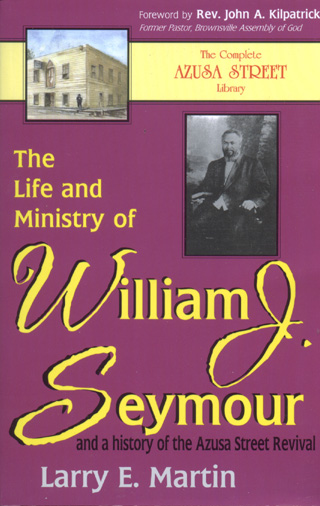Larry Martin: The Life and Ministry of William J. Seymour
 Larry Martin, The Life and Ministry of William J. Seymour: and a history of the Azusa Street Revival (Joplin, MO: Christian Life Books, 1999), 384 pages, ISBN 9780964628946.
Larry Martin, The Life and Ministry of William J. Seymour: and a history of the Azusa Street Revival (Joplin, MO: Christian Life Books, 1999), 384 pages, ISBN 9780964628946.
Dr. Larry Martin’s book The Life and Ministry of William J. Seymour is a valuable contribution to Pentecostal studies as the first volume in his series “The Complete Azusa Street Library.” Martin presents an easy reading biography of Seymour and also pieces together the history of the Azusa Street revival, drawing upon Douglas Nelson’s dissertation on Seymour (Douglas J. Nelson, For Such a Time as This: The Story of Bishop William J. Seymour and the Azusa Street Revival), Seymour’s periodical The Apostolic Faith, and Frank Bartleman’s account of the Azusa revival, as well as other many other sources and his own original research. The book is sprinkled liberally with photos and illustrations that highlight the times, culture, artifacts, places, events, and people associated with Seymour and the Azusa revival.
Martin traces the relevant history leading up to the Azusa revival, including the earlier life, times, and ministry of Charles Parham and Seymour, how they met, and the divine preparation for the Azusa revival. Through several chapters, he describes in detail the various events of the outpouring of the Holy Spirit and subsequent developments within and following the revival, including the controversies, opposition, and divisions that resulted. He also incorporates a brief chapter on the expansion of the movement throughout the United States and worldwide. One chapter is devoted to Seymour’s travels and ministry following Azusa Street, and another to the circumstances around his death and the future of his ministry and legacy after his death.
The main drawback of the book is that Martin only briefly summarizes in one chapter Seymour’s travels and ministry after the 1906 revival to his death in 1922. Seymour’s contacts and activities during this time are important features that were omitted from this otherwise insightful volume. Perhaps they will be documented more fully in a later volume. Also not mentioned is Seymour’s recanting of the evidential tongues doctrine, nor is the theology of Seymour discussed, although a later volume in the series includes Seymour’s church polity and doctrine manual. A volume discussing and evaluating his theology would be beneficial.
Despite these omissions and a few grammatical errors, Martin has provided a valuable and accessible record of Seymour’s life and ministry and the events surrounding the Azusa Street revival for the annals of Pentecostal history. I look forward to reading all the volumes in Martin’s series.
Reviewed by Paul L. King
Category: Church History, Winter 2005


